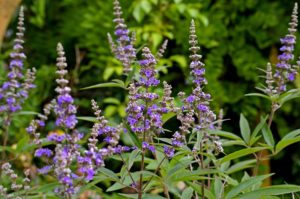Does Monk’s Pepper Help with Endometriosis?

Monk’s pepper (Vitex agnus-castus) is a well-established medicinal plant with a rich history of use in addressing women’s health issues. It has demonstrated effectiveness in managing premenstrual syndrome (PMS), infertility, and irregular menstrual cycles, as supported by scientific research [6]. Could monk’s pepper also offer benefits for endometriosis?
The colloquial name “chaste tree” provides insight into its naturopathic applications. Despite being referred to as a “tree”, monk’s pepper is actually a sizeable shrub. Throughout history, it has been employed to curb sexual desire, particularly in men, leading to its cultivation in monastery gardens. The pungent seeds, which possess a spice-like quality, contribute to this effect – a desirable outcome for monks. Yet, an intriguing aspect emerges: How might monk’s pepper’s properties be harnessed to aid women’s health?
Unlocking the Mechanism: How Monk’s Pepper Provides Relief

Harnessing relief: Monk’s pepper alleviates premenstrual symptoms, including breast pain.
The precise workings through which monk’s pepper impacts hormone regulation, specifically via the pituitary gland, remain a topic of ongoing investigation without definite conclusions. The suspected modes of action include interactions with dopamine, opioid receptors, or even estrogen-like components present in monk’s pepper [8]. What is certain is that active compounds found in the fruit of the shrub exert their influence on human hormonal balance, transcending gender boundaries [7].
A prominent example of monk’s pepper is its ability to inhibit the release of prolactin [1], a hormone crucial for functions like milk production during lactation. This inhibition contributes to the relief of breast pain (mastodynia), a notable symptom of premenstrual syndrome (PMS). Additionally, monk’s pepper offers respite from other PMS symptoms, such as water retention.
Monk’s pepper plays a pivotal role in promoting the formation of corpus luteum hormone, also known as progestins. This attribute makes it valuable in positively modulating hormones, particularly in scenarios of unfulfilled desires for pregnancy due to low progestin levels or corpus luteum weakness.
For women with irregular menstrual cycles, monk’s pepper steps in to restore normalcy. It serves as a gentle regulator whenever the female hormone equilibrium falls slightly “out of whack” [2]. Regardless of the purpose and dosage of monk’s pepper-based preparations, their hormone-regulating effects are not immediate. As such, it is advisable to consume them consistently for at least three menstrual cycles to accurately gauge their effectiveness [5].
Potential Side Effects of Monk’s Pepper
Instances of side effects from monk’s pepper are infrequent, encompassing a spectrum that includes itching, headaches, gastrointestinal issues, and occasional dizziness. While rare, allergic reactions remain a possibility. Should any of these signs manifest, seeking immediate medical attention is imperative to ensure proper care and guidance.
Monk’s Pepper and Endometriosis

The essential oil of monk’s pepper has an analgesic and anti-inflammatory effect.
Currently, limited scientific studies explore the connection between monk’s pepper and its potential role in managing endometriosis. Nonetheless, the available evidence, while promising, largely derives from scientific observations and real-world experiences.
The overarching objective in addressing endometriosis is achieving the balance of lower estrogen and higher progestin levels.
While monk’s pepper does contain estrogen-like components, the bulk of research indicates that it either does not influence or even inhibits estrogen levels. Consequently, monk’s pepper might contribute to slowing the growth of endometriosis lesions [3].
It is notable that only one solitary study noted monk’s pepper acting in a manner similar to estrogens, potentially fostering endometriosis lesion growth. In some explorations of different gynecological applications, elevated progestin concentrations were observed. This mosaic of data leans toward advocating monk’s pepper’s usage in endometriosis, albeit with certain disparities in scientific findings.
A mouse-based study [4] investigating the essential oil from monk’s pepper fruit yielded intriguing results. It substantiated the oil’s anti-inflammatory and analgesic attributes, with pain relief manifesting within a mere 15 minutes. The transference of these outcomes to humans necessitates further investigation.
The research landscape remains contentious and somewhat sparse, preventing the issuance of a definitive recommendation regarding monk’s pepper for endometriosis. Nevertheless, depending on individual circumstances and treatment plans, a three-month trial might be a worthwhile consideration!
When is Monk’s Pepper Not Recommended?

Women who take hormone preparations should avoid monk’s pepper.
For women who are on hormone preparations, antidepressants, or other medications, it is advisable to avoid monk’s pepper-based products or have detailed discussions with their attending physician. Monk’s pepper should also be avoided during breast cancer, pregnancy, and lactation, as its hormone-regulating properties could potentially lead to complications.
Conclusion:
The efficacy of monk’s pepper in alleviating symptoms of premenstrual syndrome (PMS) has been scientifically established, though results typically manifest after about three menstrual cycles. While the use of monk’s pepper lacks conclusive research, there are indications suggesting its potential for reducing inflammation, managing pain, positively influencing hormone balance and inhibiting the growth of endometriosis lesions.
Although monk’s pepper originates from a plant source, its actions mirror those of a drug, underscoring the importance of seeking medical guidance before use.
References
- Finding the Perfect Nutritionist: A Step-by-Step Guide - 5. October 2023
- Does Monk’s Pepper Help with Endometriosis? - 5. October 2023
- A Brief Overview of Dietary Fats - 29. September 2023
